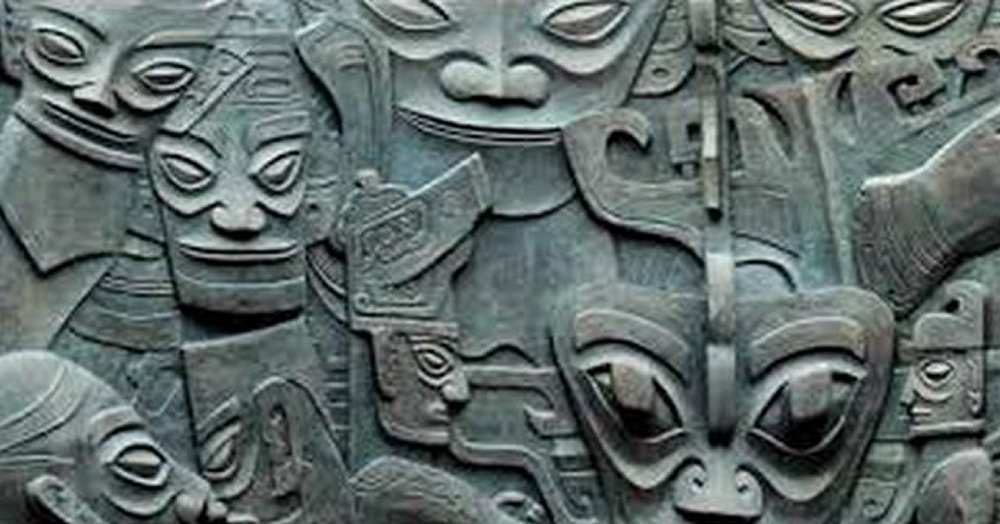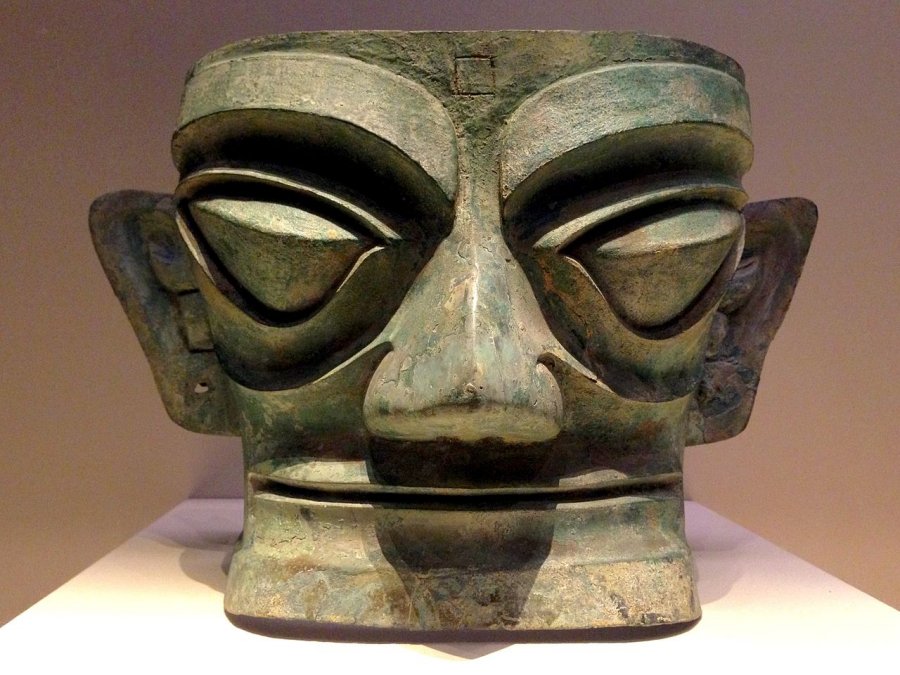Baffling Sanxingdui Civilization: Why Did These People Have Fascination For Eyes?
A. Sutherland - AncientPages.com - Sanxingdui are ruins of an ancient Chinese city with traces of a previously unknown culture dated to Bronze Age. The ruins are located in the region of Guanghan City, Sichuan Province.
This most remarkable place was first discovered in 1929 when a local farmer accidentally stumbled upon about 400 jade pieces, and these were the first Sanxingdui relics, which were discovered at the site. Since this time, the next generations of archaeologists have excavated and studied the Sanxingdui culture.
In 1986, a team of Chinese archaeologists discovered two major sacrificial pits filled with nearly
1000 bronze objects including hundreds of masks and heads, sun-shaped wares, bronze figures, bells, and a great variety of artworks made in jade, gold and stone. Many pieces of art display decorative dragons, snakes and birds, and other most curious relics that no one has ever seen.
However, no texts that could shed light on the secrets of the Sanxingdui culture were found.
Analysis of lead and other elements in the bronzes indicates sources similar to those of other cultures that lived along the lower reaches of the Yangtze River.
Altogether 120 mysterious Sanxingdui artifacts are dated from the 12th to 11th centuries BC. None of them was found marked with characters or and no historical records of the Sanxingdui culture have been found in the annals of nearby areas.
Among the artifacts, particularly intriguing are the heads (or masks), which do not appear to be human or even animal. They have very sharp features, exceptionally protruding eyes, and exaggerated ears and noses.
 Some masks portray the eyeballs sticking out of the mask-like pillars.
Some masks portray the eyeballs sticking out of the mask-like pillars.
Today, it is known that the great legacy of Sanxingdui cannot be entirely associated with the ancient kingdom of Shu, as it was previously thought.
Only a few references regarding the Shu kingdom exist in the early historical records of China until the 4th century BC. The Shu kingdom was subjugated by the state of Qin in 316 BC.
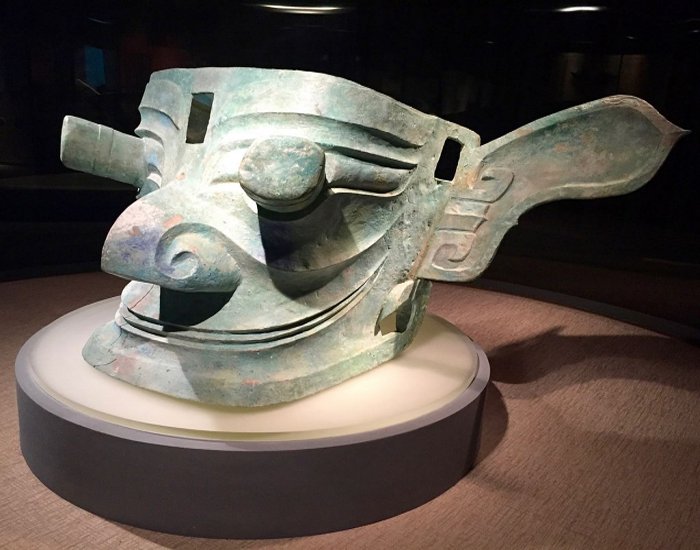
Bronze head (138 cm bred) with protruding eyes believed to be a depiction of Cancong, the semi-legendary first king of Shu. Image credit: Wikipedia
The mysterious Sanxingdui existed in this region much earlier, which was confirmed by recent archaeological excavations. But still, many archaeologists suggested the Sanxingdui culture to be part of the ancient kingdom of Shu.
Who were the people of Sanxingdui civilization? Where did they come from?
See also:
Dazu Rock Statues Of Clairvoyance And Clairaudience
Remarkable 2,000-Year-Old Smoke-Absorbing Lamps Reducing Pollution Discovered
Chang Woo Gow – The Kind And Intelligent Chinese Giant
According to the "Chronicles of Huayang" dated to the Jin Dynasty (265-420), the Shu kingdom was founded by Cancong. Cancong was described as having protruding eyes, a feature that is found in the figures of Sanxingdui. Other eye-shaped objects were also found which might suggest worship of the eyes.
Ancient Chinese myth says that Cancong was the mythical founder of the ancient Shu kingdom and the first ancestor of Shu kings. He taught techniques of silk production. His name means: Can – “silkworm” and cong means: “cluster”.
His appearance was strange, his eyes, for example, bulged in an upright position, which demonstrated his extraordinary powers. He was always seen in green clothes so he was called “Green God” or “God in Green Clothes”.
Written by - A. Sutherland - AncientPages.com Senior Staff Writer
Copyright © AncientPages.com All rights reserved. This material may not be published, broadcast, rewritten or redistributed in whole or part without the express written permission of AncientPages.com
Expand for referencesReferences:
A. P. Underhill, A Companion to Chinese Archaeology
L. Yang, Handbook of Chinese Mythology
Spara
Spara
Spara
Spara
Spara
Spara
Spara
Spara
Spara
Spara
Spara
Spara
Spara
Spara
Spara
Spara
Spara
More From Ancient Pages
-
 Early Christian Crypt Unearthed In Zaldapa Fortress, Bulgaria
News | Sep 7, 2015
Early Christian Crypt Unearthed In Zaldapa Fortress, Bulgaria
News | Sep 7, 2015 -
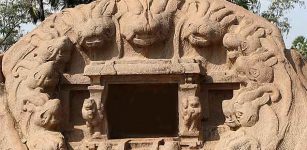 Tiger Cave: Rock-Cut Hindu Temple Complex Dated To East India’s Pallava Empire
Featured Stories | Jan 19, 2017
Tiger Cave: Rock-Cut Hindu Temple Complex Dated To East India’s Pallava Empire
Featured Stories | Jan 19, 2017 -
 Wasabi Plant Can Save Ancient Bio-Deteriorated Papyrus
Scripts, Paintings & Inscriptions | Apr 4, 2024
Wasabi Plant Can Save Ancient Bio-Deteriorated Papyrus
Scripts, Paintings & Inscriptions | Apr 4, 2024 -
 Anomalies Linked To L-Shaped Structure Detected At The Western Cemetery, Giza, Egypt
Archaeology | May 11, 2024
Anomalies Linked To L-Shaped Structure Detected At The Western Cemetery, Giza, Egypt
Archaeology | May 11, 2024 -
 Historic Shipwreck Mentor Reveals Its Underwater Secrets
Archaeology | May 14, 2022
Historic Shipwreck Mentor Reveals Its Underwater Secrets
Archaeology | May 14, 2022 -
 Oldest Human Remains Unearthed In Vietnam
Archaeology | Nov 15, 2023
Oldest Human Remains Unearthed In Vietnam
Archaeology | Nov 15, 2023 -
 New Discovery: Unknown Use Of Yellow Colors In Ancient Egypt – Revealed
Archaeology | Oct 16, 2019
New Discovery: Unknown Use Of Yellow Colors In Ancient Egypt – Revealed
Archaeology | Oct 16, 2019 -
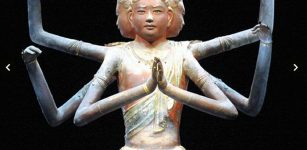 CT Scan Reveals Repairs And Damage Of 1,300-Year-Old Three-Headed And Six-Armed Statue
Archaeology | Feb 23, 2017
CT Scan Reveals Repairs And Damage Of 1,300-Year-Old Three-Headed And Six-Armed Statue
Archaeology | Feb 23, 2017 -
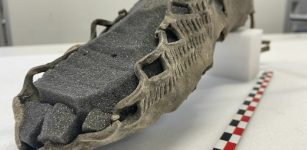 Startling Roman-Looking Sandal Discovered Buried Deep Beneath The Snow In Norwegian Mountains
Archaeology | Apr 13, 2022
Startling Roman-Looking Sandal Discovered Buried Deep Beneath The Snow In Norwegian Mountains
Archaeology | Apr 13, 2022 -
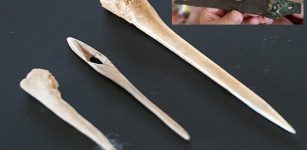 8,600-Year-Old Bone Needles Found In Denizli Closely Associated With Old Textile Tradition
Artifacts | Sep 2, 2020
8,600-Year-Old Bone Needles Found In Denizli Closely Associated With Old Textile Tradition
Artifacts | Sep 2, 2020 -
 Patara Lighthouse Built By Emperor Nero In 64 AD Will Shine Again
Archaeology | Mar 5, 2020
Patara Lighthouse Built By Emperor Nero In 64 AD Will Shine Again
Archaeology | Mar 5, 2020 -
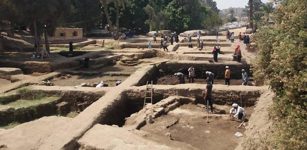 Inscribed Fragments Of Stone Slabs Unearthed In Matariya, Ancient Heliopolis
Archaeology | Nov 9, 2018
Inscribed Fragments Of Stone Slabs Unearthed In Matariya, Ancient Heliopolis
Archaeology | Nov 9, 2018 -
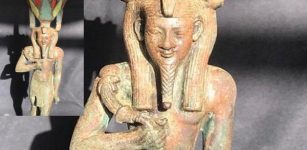 Carved Statue Of God Nefertum Unearthed In Egypt’s Saqqara Necropolis
Archaeology | Oct 3, 2020
Carved Statue Of God Nefertum Unearthed In Egypt’s Saqqara Necropolis
Archaeology | Oct 3, 2020 -
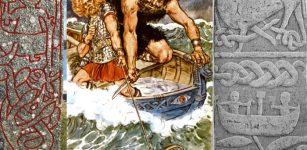 Thor And Tyr Journey To Hymir’s Hall To Steal Huge Cauldron – In Norse Mythology
Featured Stories | Jun 6, 2023
Thor And Tyr Journey To Hymir’s Hall To Steal Huge Cauldron – In Norse Mythology
Featured Stories | Jun 6, 2023 -
 Mysterious Underwater Ruins In Canada And America – Evidence Of An Unknown Ancient Civilization?
Civilizations | Sep 17, 2020
Mysterious Underwater Ruins In Canada And America – Evidence Of An Unknown Ancient Civilization?
Civilizations | Sep 17, 2020 -
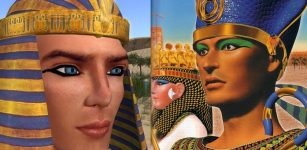 Ancient Egyptian Men Used Eye Makeup For Many Reasons
Ancient History Facts | May 9, 2016
Ancient Egyptian Men Used Eye Makeup For Many Reasons
Ancient History Facts | May 9, 2016 -
 Before The Pharaohs: The Evidence For Advanced Civilization In Egypt’s Mysterious Prehistory
Civilizations | Apr 14, 2017
Before The Pharaohs: The Evidence For Advanced Civilization In Egypt’s Mysterious Prehistory
Civilizations | Apr 14, 2017 -
 DNA Sheds New Light On The Mysterious Dead Sea Scrolls
Archaeology | Jun 2, 2020
DNA Sheds New Light On The Mysterious Dead Sea Scrolls
Archaeology | Jun 2, 2020 -
 Dingoes Given ‘Almost-Human’ Status In Pre-Colonial Australia – Archaeological Study Finds
Archaeology | Oct 21, 2023
Dingoes Given ‘Almost-Human’ Status In Pre-Colonial Australia – Archaeological Study Finds
Archaeology | Oct 21, 2023 -
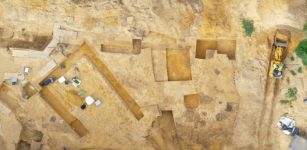 Unusual Mini Temples Discovered In Ancient Roman Camp In Haltern, Germany
Archaeology | Nov 16, 2023
Unusual Mini Temples Discovered In Ancient Roman Camp In Haltern, Germany
Archaeology | Nov 16, 2023

